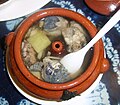|
Steaming
 Steaming is a method of cooking using steam. This is often done with a food steamer, a kitchen appliance made specifically to cook food with steam, but food can also be steamed in a wok. In the American Southwest, steam pits used for cooking have been found dating back about 5,000 years. Steaming is considered a healthy cooking technique that can be used for many kinds of foods. Compared to full immersion in boiling water, steaming can be faster and more energy-efficient because it requires less water and takes advantage of the excellent thermodynamic heat transfer properties of steam. History Some of the world's earliest examples of steam cooking were found in China's Yellow River Valley; early steam cookers made of stoneware have been found dating back as far as 5,000 BCE.[1] And also in Gunma Prefecture, Japan, created during the Stone Age.[2][3] Some of the earliest examples of steam cooking have been found in Italy and Sardinia, created during the Bronze Age,[4] and in Cochise County, Arizona, where steam pits were used for cooking about 10,000 years ago.[5] From the eighth century CE,[citation needed] thin cypress strips were used to make steamers; today, their slatted bases are constructed from bamboo. The classic steamer has a chimney in the center, which distributes the steam among the tiers.[citation needed] While steaming has not caught up in the west for assorted dishes, the technique has been heavily popularized worldwide by Chinese and East Asian cuisine.[6] The two main classic steamers feature the ancient bamboo steamer as well as the modern metal (aluminium or stainless steel) steamer, with the difference being that the bamboo lid takes longer to heat up but absorbs excess moisture and allows heat to condense again over the delicate food.[7] Other developments were the creation of microwaveable silicone steamers and plastic-hybrid steamers.[7] Method Steaming works by boiling water continuously, causing it to vaporize into steam; the steam then carries heat to the nearby food, thus cooking the food. The food is kept separate from the boiling water but has direct contact with the steam, resulting in a moist texture to the food. This differs from double boiling, in which food is not directly exposed to steam, or pressure cooking, which uses a sealed vessel but is capable of pressure steaming or submerging.[citation needed] Such cooking is most often done by placing the food in a food steamer, typically a circular container made of metal, wood, or bamboo. The steamer usually has a lid that is placed on top of the container during cooking to allow the steam to cook through the food. When a steamer is unavailable, food can be steamed inside a wok, supported over boiling water in the bottom of the wok by a metal frame. Some modern home microwave ovens include a structure to cook food with steam vapor produced in a separate water container, providing a similar result to being cooked on a stove. There are also specialized steam ovens available.[citation needed]
Steamed foods In Japan, glutinous rice is steamed to prepare mochi rice cakes. Traditional Japanese sweets or wagashi making involves steaming rice or wheat dough for making mochigashi and manju.[citation needed]  In Western cooking, steaming is most often used to cook vegetables—it is rarely used to cook meats. However, steamed clams are prepared by steaming. With Chinese cuisine, vegetables are usually stir fried or blanched and seldom steamed. Seafood and meat dishes are steamed. For example: Steamed whole fish, steamed crab, steamed pork spare ribs, steamed ground pork or beef, steamed chicken and steamed goose.[citation needed] Rice can be steamed too, although in Chinese cooking this is simply referred to as "cooking" rather than "steaming". In Thailand steaming is the definition of minimalist cooking.[8] Wheat foods are steamed as well. Examples include buns and Chinese steamed cakes. Similarly, in Mexican and Central American cuisine, tamales are made by steaming a dough made from nixtamalized maize (called masa) in wrappers made from corn husks or banana leaves; the dough can be stuffed or left plain.[citation needed] Steamed meat dishes (except fish and some dim sum) are less common in Chinese restaurants than in traditional home cooking,[9] because meats usually require longer cooking times to steam than to stir fry. Commercially sold frozen foods (such as dim sum) formerly had instructions to reheat by steaming, until the rise in popularity of home microwave ovens, which have considerably shorter cooking times.[citation needed] Chinese dishes  Staple foods
Rice
Seafood
Soup
Sweets
Others
Japanese dishes
There are recipes where sauce is added to the main ingredients, aiming to control smell or aroma, or keep moisture to the ingredients.
Recipes named after the container.
Sweets: steaming is an important process in Japanese sweets making such as manjū, yōkan, uirō, karukan or suama.
Korean dishes
BenefitsOvercooking or burning food is easily avoided when steaming it. Individuals preferring to avoid additional fat intake may prefer steaming to methods which require cooking oil.[citation needed] A 2007 USDA comparison between steaming and boiling vegetables shows the most affected nutrients are folic acid and vitamin C. When compared to raw consumption, steaming reduces folic acid by 15%, and boiling reduces it by 35%. Steaming reduces vitamin C by 15%, and boiling reduces it by 25%.[14] Steaming, compared to boiling, showed 42% higher amount of glucosinolates in broccoli cooked for medium firmness.[15] Phenolic compounds with antioxidant properties have been found to retain significantly better through steaming than through boiling or microwaving.[16] Steaming compared to boiling retained β-carotene in carrots.[17] The effect of cooking food may increase or decrease the nutrients.[14][18] See also
References
External linksWikimedia Commons has media related to Steaming. |









